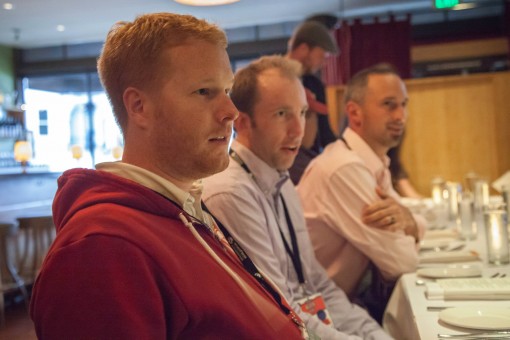I like to joke that Happy Cog and the people that work for (and with) them sometimes act as the research and development arm of the digital / interactive project management industry.
 A novel idea, writing content before design, discussed by Steph Hay at the inaugural Digital PM Summit is crazy (good) enough it could completely transform digital design projects for the better. As with any good R&D process, we may be in the early days of a complete shift in thinking (like mobile-first design has been in the past few years). Or, we may forget this entirely due to lack of buy-in and ability to ‘grok’ an alternative approach.
A novel idea, writing content before design, discussed by Steph Hay at the inaugural Digital PM Summit is crazy (good) enough it could completely transform digital design projects for the better. As with any good R&D process, we may be in the early days of a complete shift in thinking (like mobile-first design has been in the past few years). Or, we may forget this entirely due to lack of buy-in and ability to ‘grok’ an alternative approach.
That said, I recommend all digital project managers and organizations looking to do an online project in the near future and consider this approach and continue testing this approach and the resulting effects.
Approach
Beginning a project by talking about the audience(s) and precise interaction(s)s that currently do or need to happen means getting past guessing about what content elements and design templates need to be “designed” while still embracing ambiguity and figuring this out as you (or your client) go through the process.
Clients often want to see a layout or a concept, or a list of content types before “plugging in” all the final copy text, words, and so on. Once we “see it” we’ll make the content work to match the discovered goals of the design, right?
Writing content first means zooming in on a single piece of content, say a product description page, and writing precisely what needs to be on that page. Then stepping up a level, and repeating the process, and then moving sideways across all unique items in the project to see what patterns, unique elements, and hierarchy emerge.
This process allows the designer to then create a model that best fits the content presented and makes their job easier (and more successful). It could mean a designer will realize a call-out box design element is the best method to prioritize a testimonial on the page versus designing a page concept with testimonials included when the client has no real customers (or testimonials) yet. It could means noting the whimsy in the ‘voice’ on the page should be matched by the stylistic elements surrounding the page.
Read more about the specifics of the process at stephaniehay.com »
Results
Steph walked through a recent successful website re-design project she led that followed a content-first approach and I’m convinced. Both you and your clients should realize the benefits to taking this approach and see if its worth going down this content creation path up-front:
- Increases organizational capacity: if your client goes through the exercise of writing content up-front and making all the hard decisions, this then allows them to work in parallel while you begin the design process.
- Prompts for stakeholder involvement earlier: often when a design concept is presented with ‘lorem ipsum’ placeholder text, “higher ups” do not want to be involved until things are closer to completion so they can provide meaningful feedback. Having content in place flips the switch sooner to allow looking at closer-to-final artifacts.
- Gets to decisions quicker: when needing to provide feedback, a mental disconnect can happens if you’re able to skim over the placeholder text and simple assume the “right” content will fit naturally. As you write content, as you define the content and display models, the two convene sooner and allows for more acceptance, revisions, and testing along the way.
A traditional design process without content written first means you can’t discover what’s needed until you realize its missing.When a discovery like this happens so far into the implementation process it can de-rail a project with rework, missed timelines, blown budgets, and disappointed stakeholders.
Steph has a framework on how to begin a project with content discussions first that I encourage project managers to review and consider.
I’d also recommend comparing and contrasting this thinking to the traditional design approach found in typical interactive projects and considering the pros and cons of each.

